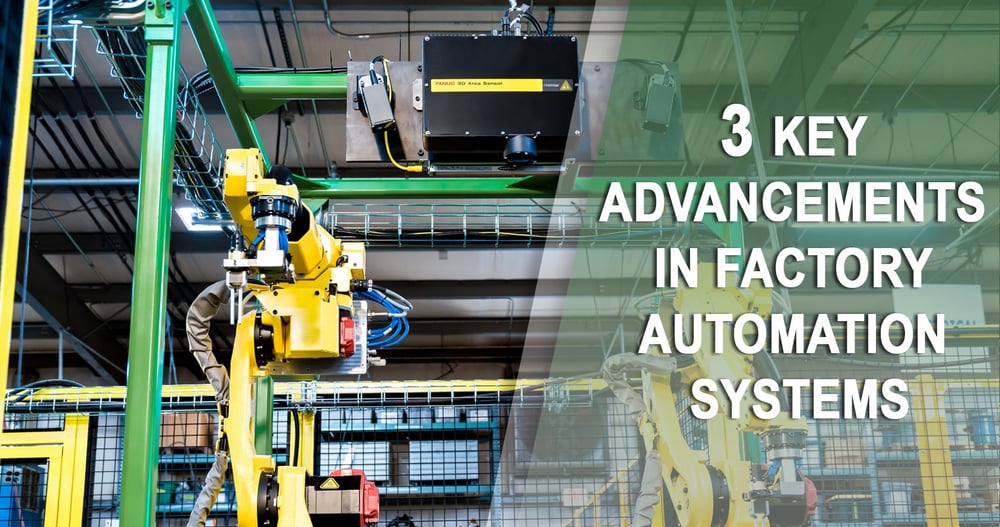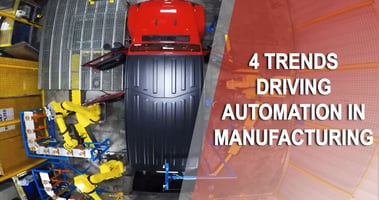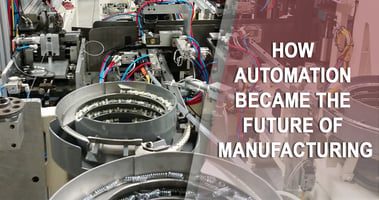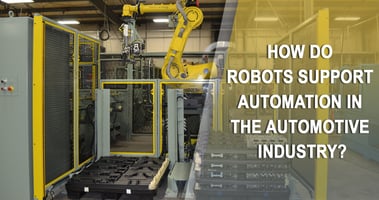Manufacturers everywhere are challenged to adopt contemporary business approaches in order to...
3 Key Advancements in Factory Automation Systems

Advances in factory automation over the last several decades have been nothing short of extraordinary. From greater efficiencies and higher standards of safety to customization and quality improvements, inspiration and innovation have brought about fresh capabilities for players across the manufacturing industry. Even so, there’s much more to be explored in terms of advancing factory automation. As new technologies emerge, it’s both important and exciting to stay informed about the latest forward movements.
To stay on the cutting edge of what’s new and notable, check out the following key advancements in today’s factory automation arena.
3D Sensing Technology
Perhaps one of the greatest game-changers currently hitting the manufacturing market is three-dimensional sensing technology. Over the next several years, we’re apt to see some major advancements in this field, specifically as it pertains to optimizing the bin picking process. In fact, functional 3D bin picking is widely considered to be the Holy Grail of material handling technology.
“Picking from a bin isn’t an easy task for a robot equipped with machine vision,” says AIA Vision Online. “Human dexterity is a skill that is a perfect combination of touch, vision, and hand-eye coordination. People can grab random parts from a bin without much thought, but robots struggle with this task. Give a robot well-arranged items and it can do the job, but toss the items in a bin and the robot struggles to even figure out what it’s seeing.”
With advancements in 3D sensing, however, organizations in the manufacturing world—from production facilities to distribution centers—are starting to see real evolution in robotic capabilities.
“For a robot to be able to effectively pick random objects from a bin, it requires a point cloud map,” explains AIA. “A point cloud is a collection of data points that are defined by a given coordinate system. To create a point cloud, a stereo machine vision camera generates a 2D depth map. Each pixel on that map is then re-projected to 3D space. This results in a 3D model that is highly accurate… Digital imaging, recognition, data processing, and optical technologies serve as the ‘eyes’ and ‘brain’ of industrial robots, allowing them to meet the requirements of high accuracy, speed, and low maintenance.”
Particularly in the wake of Covid-19 and its cascade of industry impacts, advancements in 3D sensing are bound to create profound opportunities for manufacturing and distribution. From depalletizing skids of random products to enhancing shipping with case-packing applications, there’s much to be gleaned from 3D sensing capabilities in these areas.
The global pandemic has changed the way consumers shop, generating major waves for logistics and supply chain management. In essence, the threat of significant health risks has maximized the need—and expedited the technology—for the kind of advancements in 3D sensing that the industry has been eyeing for some time now.
Artificial Intelligence
In tandem with 3D sensing technology, artificial intelligence is enabling automated systems to actually learn. Where we’ve already started to see this take effect (and are poised to see it amplified) is with 2D and 3D vision technologies.
Consider, for example, how technology provides the impetus to “train” a camera to perform specific functions based on set tolerances. As the camera begins to see variances in those tolerances, it will automatically account for them by changing exposure settings, light intensity, etc.
A perfect example of why this is so beneficial is the challenge of lighting changes within a facility. Even a small fluctuation in lighting (one that’s not usually detectable to the human eye), can totally send factory automation systems out of whack, incurring downtime and the expense of machine service. With AI for vision technology, however, these systems have the capacity to adjust to such lighting fluctuations on their own.
In addition, there’s been advancement in automation’s ability to teach itself, specifically with regard to monitoring and maintenance. We’re poised to see machines equipped with the intelligence to pinpoint when some element of their makeup is wearing out and then change their motion profile accordingly, making themselves more efficient.
A study of AI in manufacturing operations recently highlighted by Forbes indicates that “29% of AI implementations in manufacturing are for maintaining machinery and production assets.” The research shows that “predicting when machines/equipment are likely to fail and recommending optimal times to conduct maintenance (condition-based maintenance) is the most popular use case of AI in manufacturing today.” In fact, FANUC has already established a Zero Down Time software package that enables robots to identify when their parts require maintenance.
Expect to see even greater innovation in artificial intelligence on the horizon, as immense investments are being made in the areas of research and development.
Advanced Collaborative Applications
Last (but certainly not least) is the continuing advancement of collaborative applications in factory automation.
“Collaborative robots (cobots) are providing manufacturers with safe, versatile, easy-to-use automation that supports human laborers,” says the Robotic Industries Association (RIA). “Ergonomically designed machines serve a wide variety of human needs and offer a broad range of capabilities. Cobots are actually improving work conditions and empowering humans to have more fulfilling jobs in manufacturing industries.”
And given the realities of the current pandemic, one of the greatest opportunities for impact is with assembly lines where workers are in close proximity to one another.
“As factories come back on line and essential businesses that never went off line continue to face daily challenges of operating amidst a global pandemic, attention falls squarely on the health and safety of workers,” explains RIA. “The U.S. Centers for Disease Control and Prevention (CDC) lists distance between workers and contact with contaminated surfaces as distinct factors that impact workers’ risk for exposure to the novel coronavirus. Focusing on COVID-19 risks in the workplace has shed new light on the benefits of automation, especially robots… Often used to augment human workers or assume their tasks so the humans can move to more value-added and fulfilling work, cobots have a reputation for raising the human condition.”
One of the biggest remaining challenges in this arena is the speed limitations enforced by governing safety codes, which have disqualified a number of application opportunities. With the advancement of other technologies, however, it’s possible that we’ll see an ability to increase the pace of robots while safely working in tandem with humans.
Regardless of what’s next for the future of factory automation, one thing is clear: Advancement never ceases. Technology will continue to evolve, and new advancements will continue to emerge, creating a myriad of advantages for manufacturers. If you’re on a path to integrate new automation solutions within your own factory, be sure to approach the effort with a fundamental connection to your organization’s unique business goals.
Download 7 Ways Automation Makes Manufacturers More Competitive to learn more about gleaning a competitive edge with manufacturing automation.



